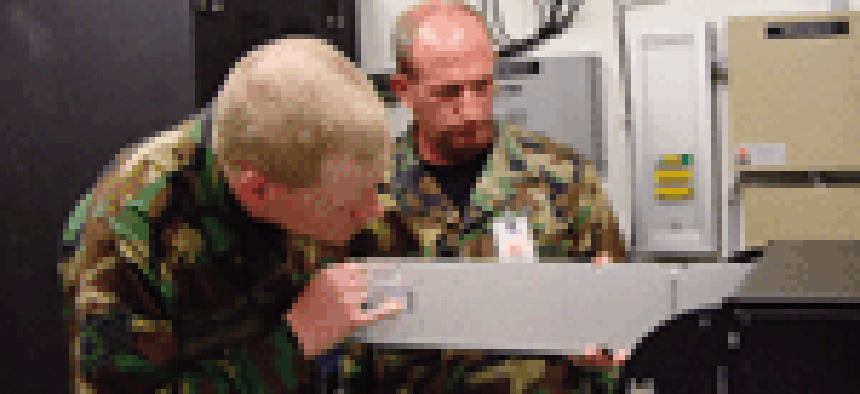AF medical office hopes rack-mount PCs are cure for costs

An Air Force medical clinic in Utah is testing more than just blood pressure and eyesight. The 75th Medical Group at Hill Air Force Base is trying out a centralized system of rack-mount blade PCs to see if they will save time and money compared with standard desktop clients.
An Air Force medical clinic in Utah is testing more than just blood pressure and eyesight. The 75th Medical Group at Hill Air Force Base is trying out a centralized system of rack-mount blade PCs to see if they will save time and money compared with standard desktop clients.If the test shows the clinic can reduce total costs, Air Force Capt. Timothy Ohrenberger, the clinic's chief information officer, said he wants to see a choice of distributed or rack-mount PCs offered to all Air Force medical centers as they refresh their technology.In May, Ohrenberger and his staff installed 44 blade computers, manufactured by ClearCube Technology Inc. of Austin, Texas, in an annex to the 75th Medical Group's main building.ClearCube Technology makes rack-mount CPUs that link to desktop components via 10/100-Mbps ethernet and a C/Port, a small box placed near users' desks. The ClearCube cages, 5.25-inch-high racks that can hold up to eight blades each, remain in a data center that can be up to 200 meters from the users.Ohrenberger's team is testing the system at flight medicine, physical examination, pediatric and optometry clinics for the Air Force Materiel Command. The clinics use the Composite Health Care System for patient records, optometry software for ordering eyeglasses and standard e-mail and desktop applications.The 44 ClearCube blade clients, temporarily replacing 42 PCs with two blades reserved as spares, are only a fraction of about 400 standard PCs on the clinic's network, Ohrenberger said.After being briefed early this year by ClearCube officials and doing a cost study, Ohrenberger wrote a proposal to the Air Force Medical Support Agency to fund a test.The medical group's PCs are on a three-year life cycle ? one-third are replaced every year. When the clinic got a new shipment of PCs in January, its IT staff started to document the time required for support. Now they are collecting the same data for the ClearCube blade clients, "from receiving them at the dock to imaging them, to putting them on the desks, to supporting them when they break," Ohrenberger said.By mid-July, the medical group should have enough data to reach a conclusion about savings. For example, if the clinic's help desk gets a phone call about a PC that broke down, someone must physically move that employee's computer off the desk, get another one ready and hook it up.In the ClearCube environment, the administrator can immediately transfer the worker to a spare blade PC, Ohrenberger said. The staff can then repair the problem client when they have the time.Users don't always back up their work, Ohrenberger said. In the ClearCube environment, however, an administrator can take a snapshot of all the PCs at one time.Since the ClearCube system debuted, the company has added management functions, said Mike Frost, ClearCube chief executive officer. The software lets administrators manage the blade PCs remotely.The ClearCube blades are somewhat more expensive than desktop PCs with the newest 2.4-GHz Pentium 4 processors. Ohrenberger's proposal estimated about $101,715 for the 44-seat pilot.Over the life cycle, however, Ohrenberger said he believes the blades will shave administrative costs.


Staff Sgt. William Zachary (left) and Capt. Timothy Ohrenberger slide a ClearCube blade into its rack at the 75th Medical Group clinic at Hill Air Force Base, Utah.

